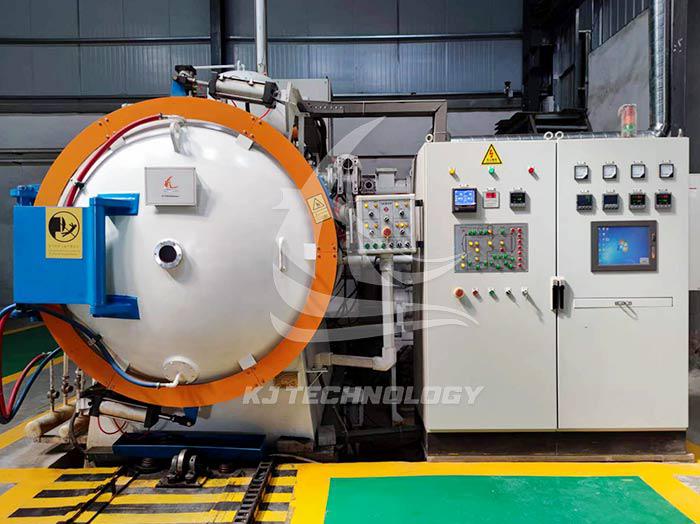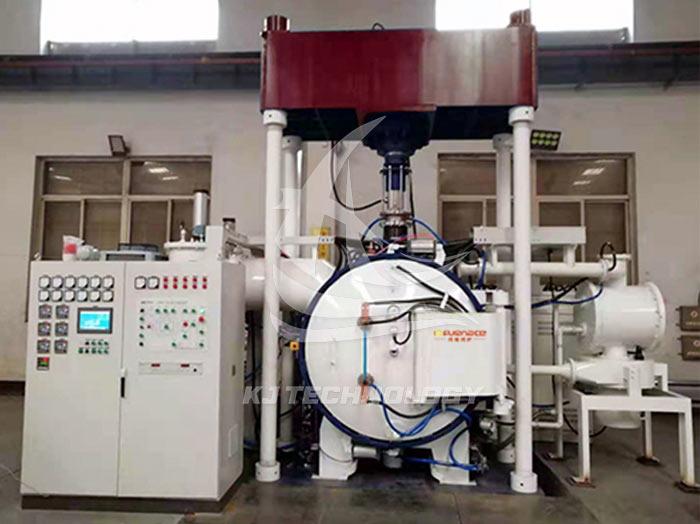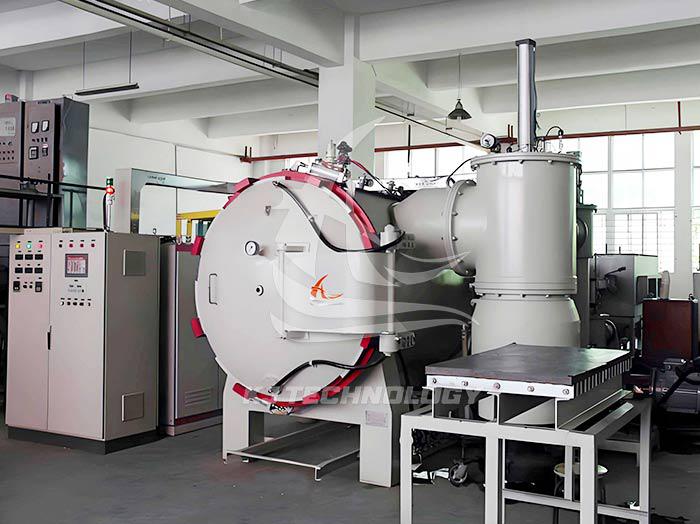Precautions for using customized vacuum annealing furnace
 06-18-2025 Author: KJ technology
06-18-2025 Author: KJ technology
During the use of customized vacuum annealing furnaces, systematic management should be carried out from four dimensions: operating standards, safety protection, equipment maintenance, and process optimization. The following are specific precautions and instructions:
1. Operating standards
temperature control
Heating rate: Set according to material characteristics (such as titanium alloy ≤ 10 ℃/min to avoid abnormal grain growth).
Insulation time: Calculated based on the thickness of the workpiece (e.g. insulation for 1 hour every 25mm thickness to ensure uniform organization).
Cooling control: Adopt segmented cooling (such as cooling the high-temperature section along with the furnace, and accelerating the cooling by introducing inert gas into the low-temperature section).
Vacuum degree management
Vacuum pumping process: First, the mechanical pump roughly pumps to below 10Pa, and then switches to the molecular pump high vacuum (≤ 1 × 10 ⁻ ³ Pa).
Leakage rate detection: Use a helium mass spectrometer leak detector to detect leaks every month, with a leakage rate of ≤ 1 × 10 ⁻⁹ Pa · m ³/s.
Atmosphere switching: After the vacuum degree stabilizes, slowly fill the protective gas (such as argon flow rate ≤ 5L/min).
Loading requirements
Workpiece spacing: Maintain a spacing of ≥ 50mm to avoid thermal radiation obstruction.
Loading capacity: not exceeding 80% of the furnace volume, ensuring uniform airflow.
Cleanliness: The surface of the workpiece should be free of oil stains and rust, and cleaned with acetone or alcohol.
2. Security protection
Electrical safety
Grounding resistance: ≤ 4 Ω, tested once a month.
Insulation test: Use a 500V megohmmeter to test, with insulation resistance ≥ 1M Ω.
Emergency stop device: One emergency stop button is installed at the front and rear of the furnace, with a response time of ≤ 0.5 seconds.
Pressure safety
Blasting disc: set at a critical position in the vacuum pipeline, with a blasting pressure of 0.1-0.15MPa.
Pressure monitoring: Real time display of furnace pressure, automatic alarm for overpressure and cutting off heating.
high temperature protection
Thermal insulation screen: using 5-layer molybdenum screen, surface temperature ≤ 60 ℃ (when the ambient temperature is 25 ℃).
Operation protection: Operators must wear insulated gloves and protective face shields, and be at least 1 meter away from the furnace body.
3. Equipment maintenance
Routine maintenance
Cleaning the furnace: Clean the residue after each use and wipe it with a dust-free cloth.
Check the sealing ring: Check the wear of the O-ring every week, with a replacement cycle of ≤ 6 months.
Lubrication and maintenance: Add high-temperature lubricating grease to transmission components (such as furnace door lifting mechanism) every month.
Regular maintenance
Heating element: Check the resistance value quarterly and replace it if the deviation exceeds ± 5%.
Vacuum pump: Change the engine oil and clean the oil mist separator every six months.
Thermocouple: Calibrate once a year and replace when the error exceeds ± 1 ℃.
Spare parts Management
Key spare parts: reserve heating elements, vacuum pump oil, O-rings, etc., with inventory of ≥ 3 months of usage.
Supplier response: Request spare parts suppliers to provide technical support within 24 hours.
4. Process optimization
Parameter record
Data collection: Record parameters such as temperature, vacuum degree, gas flow rate, etc., with a storage period of ≥ 2 years.
Curve analysis: Use heat treatment software (such as JMatPro) to analyze the heating/cooling curve and optimize the process.
energy efficiency management
Insulation material: 128kg/m ³ alumina fiber felt is used to reduce heat loss.
Waste heat recovery: Install a heat exchanger to recover cooling water waste heat for preheating workpieces.
Quality traceability
Batch management: Number each batch of workpieces, record process parameters and test results.
Failure analysis: Conduct metallographic analysis on non-conforming products (such as using OM/SEM) to trace process issues.
5. Exception handling
Abnormal temperature
Overtemperature alarm: Immediately cut off the heating power and start the water cooling system.
Slow heating: Check if the heating element is in good contact and if the resistance value is normal.
Abnormal vacuum degree
Leakage: Separate the furnace body in sections and use a helium leak detector to locate the leakage point.
Pump set failure: Switch to standby pump, check oil level and quality.
Workpiece issues
Deformation: Optimize the clamping method and increase support points.
Oxidation: Check the vacuum degree and the purity of the protective gas, and add a deoxygenation device if necessary.
Summarize
The use of customized vacuum annealing furnaces requires the establishment of standardized operating procedures (SOP) and the reduction of failure rates through preventive maintenance (such as TPM) and continuous improvement (such as PDCA cycle). Suggestion:
Develop the "Vacuum Annealing Furnace Operation Manual" and clarify the responsible persons for each link;
Conduct a quarterly equipment status assessment (such as FMEA analysis);
Sign long-term maintenance agreements with equipment suppliers to ensure technical support.
Through systematic management, equipment utilization rate (target ≥ 85%) and product qualification rate (target ≥ 99%) can be significantly improved.








